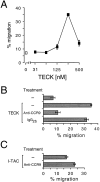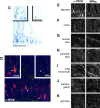Lymphocyte CC chemokine receptor 9 and epithelial thymus-expressed chemokine (TECK) expression distinguish the small intestinal immune compartment: Epithelial expression of tissue-specific chemokines as an organizing principle in regional immunity
- PMID: 10974041
- PMCID: PMC2193265
- DOI: 10.1084/jem.192.5.761
Lymphocyte CC chemokine receptor 9 and epithelial thymus-expressed chemokine (TECK) expression distinguish the small intestinal immune compartment: Epithelial expression of tissue-specific chemokines as an organizing principle in regional immunity
Abstract
The immune system has evolved specialized cellular and molecular mechanisms for targeting and regulating immune responses at epithelial surfaces. Here we show that small intestinal intraepithelial lymphocytes and lamina propria lymphocytes migrate to thymus-expressed chemokine (TECK). This attraction is mediated by CC chemokine receptor (CCR)9, a chemoattractant receptor expressed at high levels by essentially all CD4(+) and CD8(+) T lymphocytes in the small intestine. Only a small subset of lymphocytes in the colon are CCR9(+), and lymphocytes from other tissues including tonsils, lung, inflamed liver, normal or inflamed skin, inflamed synovium and synovial fluid, breast milk, and seminal fluid are universally CCR9(-). TECK expression is also restricted to the small intestine: immunohistochemistry reveals that intense anti-TECK reactivity characterizes crypt epithelium in the jejunum and ileum, but not in other epithelia of the digestive tract (including stomach and colon), skin, lung, or salivary gland. These results imply a restricted role for lymphocyte CCR9 and its ligand TECK in the small intestine, and provide the first evidence for distinctive mechanisms of lymphocyte recruitment that may permit functional specialization of immune responses in different segments of the gastrointestinal tract. Selective expression of chemokines by differentiated epithelium may represent an important mechanism for targeting and specialization of immune responses.
Figures





Similar articles
-
CCR9-positive lymphocytes and thymus-expressed chemokine distinguish small bowel from colonic Crohn's disease.Gastroenterology. 2001 Aug;121(2):246-54. doi: 10.1053/gast.2001.27154. Gastroenterology. 2001. PMID: 11487533
-
The role of thymus-expressed chemokine and its receptor CCR9 on lymphocytes in the regional specialization of the mucosal immune system.J Immunol. 2000 Nov 1;165(9):5069-76. doi: 10.4049/jimmunol.165.9.5069. J Immunol. 2000. PMID: 11046037
-
Demonstration of functional role of TECK/CCL25 in T lymphocyte-endothelium interaction in inflamed and uninflamed intestinal mucosa.Am J Physiol Gastrointest Liver Physiol. 2004 Mar;286(3):G458-66. doi: 10.1152/ajpgi.00167.2003. Epub 2003 Oct 30. Am J Physiol Gastrointest Liver Physiol. 2004. PMID: 14592943
-
Chemokine receptors and leukocyte trafficking in the mucosal immune system.Immunol Res. 2004;29(1-3):283-92. doi: 10.1385/IR:29:1-3:283. Immunol Res. 2004. PMID: 15181289 Review.
-
Features and functions of gamma delta T lymphocytes: focus on chemokines and their receptors.Crit Rev Immunol. 2003;23(5-6):339-70. doi: 10.1615/critrevimmunol.v23.i56.10. Crit Rev Immunol. 2003. PMID: 15030305 Review.
Cited by
-
CXCL17 is a mucosal chemokine elevated in idiopathic pulmonary fibrosis that exhibits broad antimicrobial activity.J Immunol. 2012 Jun 15;188(12):6399-406. doi: 10.4049/jimmunol.1102903. Epub 2012 May 18. J Immunol. 2012. PMID: 22611239 Free PMC article.
-
Chemokines and their receptors as potential targets for the treatment of asthma.Br J Pharmacol. 2007 Jul;151(6):725-36. doi: 10.1038/sj.bjp.0707263. Epub 2007 Apr 30. Br J Pharmacol. 2007. PMID: 17471178 Free PMC article. Review.
-
Human immunodeficiency virus type 1 induces persistent changes in mucosal and blood gammadelta T cells despite suppressive therapy.J Virol. 2003 Oct;77(19):10456-67. doi: 10.1128/jvi.77.19.10456-10467.2003. J Virol. 2003. PMID: 12970431 Free PMC article.
-
Expanded B cell population blocks regulatory T cells and exacerbates ileitis in a murine model of Crohn disease.J Clin Invest. 2004 Aug;114(3):389-98. doi: 10.1172/JCI20855. J Clin Invest. 2004. PMID: 15286805 Free PMC article.
-
Saccharomyces cerevisiae modulates immune gene expressions and inhibits ETEC-mediated ERK1/2 and p38 signaling pathways in intestinal epithelial cells.PLoS One. 2011 Apr 4;6(4):e18573. doi: 10.1371/journal.pone.0018573. PLoS One. 2011. PMID: 21483702 Free PMC article.
References
-
- Zlotnik A., Yoshie O. Chemokinesa new classification system and their role in immunity. Immunity. 2000;12:121–127. - PubMed
-
- Campbell J.J., Butcher E.C. Chemokines in tissue-specific and microenvironment-specific lymphocyte homing. Curr. Opin. Immunol. 2000;12:336–341. - PubMed
-
- Campbell J.J., Haraldsen G., Pan J., Rottman J., Qin S., Ponath P.D., Andrew D.P., Warnke R., Ruffing N., Kassam N. The chemokine receptor CCR4 in vascular recognition by cutaneous but not intestinal memory T cells. Nature. 1999;400:776–780. - PubMed
-
- Zabel B.A., Agace W.W., Campbell J.J., Heath H.M., Parent D., Roberts A.I., Ebert E.C., Kassam N., Qin S., Zovko M. Human G protein–coupled receptor GPR-9-6/CC chemokine receptor 9 is selectively expressed on intestinal homing T lymphocytes, mucosal lymphocytes, and thymocytes and is required for thymus-expressed chemokine–mediated chemotaxis. J. Exp. Med. 1999;190:1241–1255. - PMC - PubMed
Publication types
MeSH terms
Substances
Grants and funding
LinkOut - more resources
Full Text Sources
Other Literature Sources
Molecular Biology Databases
Research Materials

